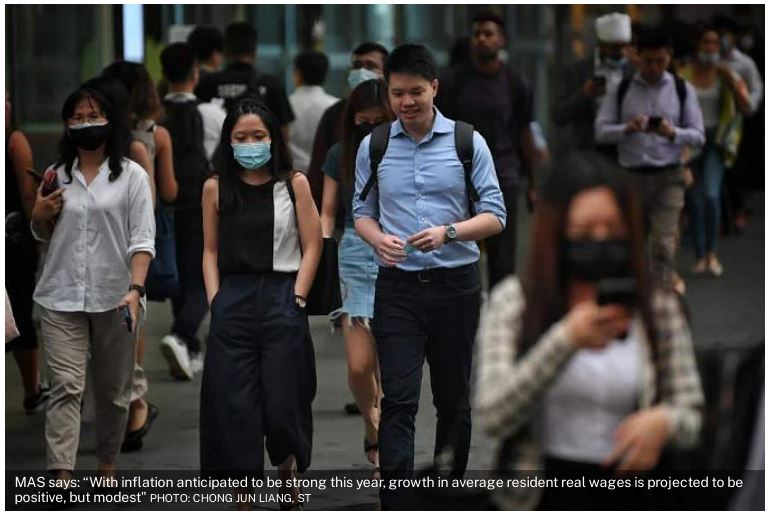Singapore’s inflation to slow but stay high in 2023 as firms pass on costs: MAS
SINGAPORE’S core inflation is expected to be driven more by domestic inflation than external pressures in 2023, with inflation slowing but staying high over the course of the year, according to the Monetary Authority of Singapore’s (MAS) latest macroeconomic review on Thursday (Oct 27).
Domestic inflation is likely to persist at elevated rates for some time, “as firms adjust prices to catch up with the steep increases in input costs that have accumulated along production chains”, said MAS in its half-yearly report.
More domestic businesses are likely to renew contracts, such as those for electricity and wages, at higher rates.
In contrast, on the external front, easing supply constraints and weakening global demand should bring commodity prices down. “The direct effects of externally driven components such as energy-related and non-cooked food items on Singapore’s CPI (consumer price index) should decline,” MAS said.
But inflation of imported services and goods will remain firm, as “still-elevated electricity and fuel costs as well as strong wage growth in many of Singapore’s major trading partners will continue to filter through global supply chains”.

MAS reiterated its 2023 projections for core inflation – which exclude accommodation and private transport costs – to average 3.5 to 4.5 per cent, and headline inflation to average 5.5 to 6.5 per cent.

The macroeconomic review included a study on how global input prices have affected Singapore. It found that recent spikes in global energy and agriculture prices explain over two-thirds of core inflation pressures in Singapore over June 2021 to June 2022.
“In Singapore, most of the international price effects on the domestic sectors are transmitted via intermediary sectors located abroad,” the study said. This is in contrast to the United States and European Union, where global energy and agriculture costs contribute to inflation via domestic supply chains.
Another study included in the review, which discussed drivers of inflation in the Asean+3 economies, found that oil price shocks impacted inflation in the region’s economies differently, with Asean-5 countries, including Singapore, being more significantly impacted than the Plus-3 countries, but less than Brunei, Cambodia, Laos, Myanmar and Vietnam.
“A one percentage point year-on-year increase in oil prices raises the region’s year on year headline inflation by 0.02 percentage point on average over the next 12 months,” the study said. “The 60 per cent year-on-year rise in crude oil prices on average over January to July 2022 would increase CPI inflation by… 1.2 percentage points in the Asean-5”.
Contributing to the differences are economic structure and policy regime: “oil price shocks have a smaller effect on inflation in net energy exporters compared to net energy importers and appear to generate a more muted inflation response in inflation-targeting regimes”.
Besides imported inputs, domestic wage growth is another contributor to inflation. In 2023, wage growth is expected to slow but remain slightly above pre-Covid rates – even though labour shortages are projected to ease in the second half of 2022. This lag is because it takes about three quarters for the effects of labour market tightness to pass through fully to nominal wage growth, said the MAS.
On a quarter-on-quarter seasonally adjusted basis in Q2 2022, nominal resident wage growth slowed to 1.5 per cent, down from 1.7 per cent in Q1 and from the peak of 2.3 per cent in Q4 2021. But this was still almost double its historical norm.
Similarly, on year, nominal resident wage growth stayed elevated at 6.8 per cent in Q2, though down from 7.8 per cent in Q1. Wages were 2.7 per cent above the level implied by the pre-Covid trend.
The MAS also noted some short-term boosts to wage growth. First, there is room for wages to catch up to pre-Covid trends in industries that were hit hard by Covid-19, such as travel. Second, low-wage worker policies are estimated to give a direct boost of about 0.2 percentage point to average resident wage growth for this year.
“Third, amid the rising cost of living and expectations that wage and price levels have permanently stepped up, workers are likely to seek (and get) above-average wage increments,” said the MAS.
As for a possible wage-price spiral – where higher consumer prices cause workers to demand higher wages, thus increasing business costs and prompting further price hikes – MAS said that the risk of this “is assessed to be low, primarily as the effect of price pressures on wage increases is empirically weak”.
But nominal resident wage growth “could remain somewhat elevated above pre-Covid averages if inflation expectations remain persistently high”, it added.
“With inflation anticipated to be strong this year, growth in average resident real wages is projected to be positive, but modest.”
Overall labour demand is expected to “soften somewhat but remain broadly supported” next year. Slowing global growth and tightening financial conditions will moderate demand, particularly in export-oriented manufacturing and modern services sectors. Robust inflows of non-resident workers are also expected to ease labour supply constraints.
While core inflation will rise in Q1 2023 with the hike in the goods and services tax (GST) in January, the impact of the latter should be temporary, said MAS. Excluding the effects of the GST increase, core and headline inflation are expected to average 2.5 to 3.5 per cent and 4.5 to 5.5 per cent respectively in 2023.
Source: https://www.businesstimes.com.sg/government-economy/singapores-inflation-to-slow-but-stay-high-in-2023-as-firms-pass-on-costs-mas


 English
English




